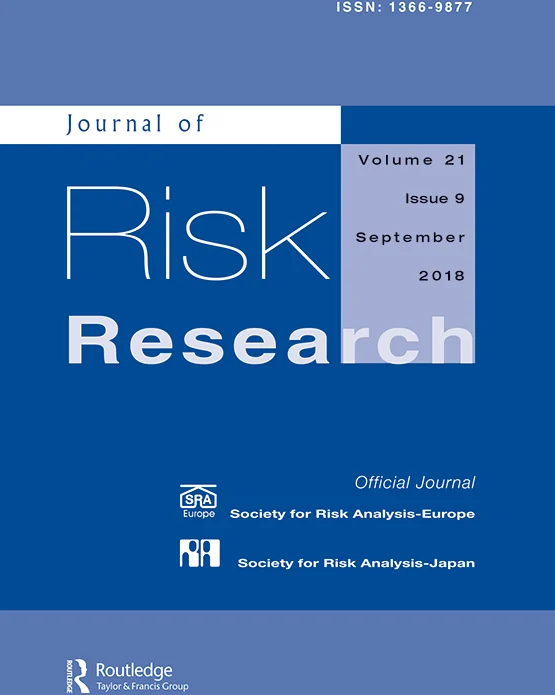监管成本和收益之间的国家偏好权衡:测试单位询问和双框架效应
IF 1.7
4区 管理学
Q1 SOCIAL SCIENCES, INTERDISCIPLINARY
引用次数: 3
摘要
摘要一种新的陈述偏好方法,通过估算生命价值来估计监管收益,引发了人们代表国家在国家监管成本和全国监管收益之间的偏好权衡,与传统的方法不同,传统的方法是通过询问受试者个人愿意为自己的死亡风险的小幅降低支付多少来寻求“统计生命价值”(VSL)的估计。在这里进行了两次国家偏好调查实验。美国第一个实验(n = 396)提供了一项人与人之间的测试,即在评估延长100条生命的假设性法规对国民经济的可承受成本(LF框架)之前,要求人们评估法规延长的假设性单一生命的效果。该单元要求任务增加了国家权衡中延长寿命社会效益的估算平均数(SB1LP*)。对产生特别低的隐含SB1LP*值的应答的警告并没有实质性地降低不可信的值。美国的第二个实验(n = 505)让人们对生命优先(LF)框架和成本优先(CF)框架做出反应(即,如果估计的监管成本为每年10亿美元,则得出“合理”的延长生命数量)。这些框架都模仿了监管机构面临的决策类型,而VSL声明的偏好方法则没有。早期人与人之间研究中较高的LF值在这里的人内设计单元中得到了复制。第二个实验出现了偏序效应:从CF帧开始,随后的LF平均值高出四倍。开放式调查发现,只有延长许多人的寿命才能证明监管成本是合理的,这可能解释了CF值较低的原因。使用这两个框架可以为传统的陈述偏好研究(仅使用LF框架)和监管机构提供信息。本文章由计算机程序翻译,如有差异,请以英文原文为准。
Stated-preference tradeoffs between regulatory costs and benefits: testing unit asking and double framing effects
Abstract A novel stated-preferences approach to imputing the value of life to estimate regulatory benefits elicits people’s preferred tradeoffs on behalf of the nation between national regulatory costs and nation-wide regulatory benefits, in contrast to the conventional approach of seeking estimates of the ‘value of a statistical life’ (VSL) by asking subjects how much they would be willing to pay personally for a small reduction in their own mortality risk. Two national-preference survey experiments were pursued here. The first U.S. experiment (n = 396) offered a between-person test of the effect of asking people to evaluate a hypothetical single life prolonged by regulation, before assessing the tolerable cost to the national economy of a hypothetical regulation prolonging 100 lives (LF frame). This unit asking task increased imputed means for the social benefit of a life prolonged (SB1LP*) in national tradeoffs. Cautions to respondents about responses that generated particularly low implicit SB1LP* values did not substantively reduce implausible values. The second U.S. experiment (n = 505) had people respond to both the lives-first (LF) frame, preceded by a unit asking task, and the costs-first (CF) frame (i.e. eliciting ‘reasonable’ numbers of lives prolonged if estimated regulatory cost is $1 billion each year). These frames both mimic the kinds of decisions that regulators face, as the VSL stated preference method does not. Higher LF values in earlier between-person studies were replicated in the unit asking within-person design here. A partial order effect occurred for the second experiment: starting with the CF frame yielded a subsequent LF mean four times higher. Open-ended probing found beliefs that regulatory costs are justified only by prolonging many lives may explain lower CF values. Using both frames can inform both conventional stated preference research (which uses only the LF frame) and regulators.
求助全文
通过发布文献求助,成功后即可免费获取论文全文。
去求助
来源期刊

Journal of Risk Research
SOCIAL SCIENCES, INTERDISCIPLINARY-
CiteScore
12.20
自引率
5.90%
发文量
44
期刊介绍:
The Journal of Risk Research is an international journal that publishes peer-reviewed theoretical and empirical research articles within the risk field from the areas of social, physical and health sciences and engineering, as well as articles related to decision making, regulation and policy issues in all disciplines. Articles will be published in English. The main aims of the Journal of Risk Research are to stimulate intellectual debate, to promote better risk management practices and to contribute to the development of risk management methodologies. Journal of Risk Research is the official journal of the Society for Risk Analysis Europe and the Society for Risk Analysis Japan.
 求助内容:
求助内容: 应助结果提醒方式:
应助结果提醒方式:


